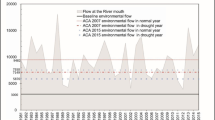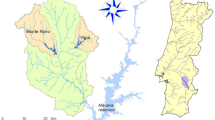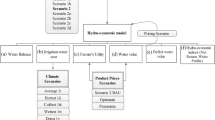Abstract
Hydro-economic models can measure the economic effects of different reservoir operating rules, environmental restrictions, maintenance of ecosystems, technical constraints, institutional constraints, land use change, and climate change. To determine the optimal economic water allocation, for its main uses in the sub-middle of the São Francisco River Basin, a hydro-economic optimization model was developed and applied. Demand curves were used rather than fixed requirements for water resources. The results show that operation rules of reservoirs and institutional constraints, such as priorities for human consumption, have high impacts on costs and benefits of the principal economic uses in the study area. Especially, costs of environmental demands, like minimum ecological river flow, have high impacts on the water resource management. Scarcity costs of irrigation users associated with maintaining ecosystems and environmental constraints are particularly significant. The results from this study provide a better understanding of the water trade-offs for future policymaking and efficient water management. Policymaking for the water resources should consider the food-water-energy-environment nexus at a regional scale to minimize environmental and economic cost under water scarcity and land use change.


Similar content being viewed by others
References
Alcoforado de Moraes MMG, Biewald A, Carneiro ACG, Souza da Silva GN, Popp A, Lotze-Campen H (2018) The impact of global changes on economic values of water for Public Irrigation Schemes at the São Francisco river basin in Brazil. Reg Environ Chang. https://doi.org/10.1007/s10113-018-1291-0
Alcoforado de Moraes MMG, Cai X, Ringler C, Albuquerque BE, Vieira da Rocha SP, Amorim CA (2010) Joint water quantity-quality management in a biofuel production area—integrated economic-hydrologic modeling analysis. J Water Resour Plan Manag 136(4):502–511. https://doi.org/10.1061/(ASCE)WR.1943-5452.0000049
Alcoforado de Moraes MMG, Cirilo JA, Sampaio Y (2006) Integração dos Componentes Econômico e Hidrológico na Modelagem de Alocação Ótima de Água para Apoio a Gestão de Recursos: Uma Aplicação na bacia do Pirapama Revista Economia, vol 7, n° 2
ANA (2011) Resolução 461. Brasilia
Arnold JG, Allen PM, Bernhardt G (1993) A comprehensive surface groundwater flow model. J Hydrol 142:47–69. https://doi.org/10.1016/0022-1694(93)90004-S
Biewald A, Lotze-Campen H, Schmitz C, Kölling K, Beck F The impact of future climate and socioeconomic changes on landuse in the catchment area of the Rio São Francisco. In: Proceedings INNOVATE Status Conference, Recife, 2014
Booker JF, Michelsen AM, Howitt RE, Young RA (2012) Economics and the modeling of water resources and policies. Nat Resour Model J 25:168–218. https://doi.org/10.1111/j.1939-7445.2011.00105.x
Brasil (1997) Lei N° 9.433, de 8 de Janeiro de 1997.Institui a Política Nacional de Recursos Hídricos, cria o Sistema Nacional de Gerenciamento de Recursos Hídricos
Brasil (2006) Decreto N° 5.995. Brasilia
Brasil (2013) Lei Federal N° 12.783, de 11 de janeiro de 2013. Brasilia
Brasil (2015) Lei federal N° 13.182, de 3 de novembro de 2015. Brasilia
Castro CNd(2011) Transposição do rio São Francisco: Análise de oportunidade do projeto. Rio de Janeiro
CBHSF (2004) Plano Decenal de Recursos Hídricos da Bacia Hidrográfica do Rio São Francisco. CBHSF, São José
EMPRAPA (2008) Solos do submédio do vale do São Francisco. Embrapa Semi-árido, Petrolina - PE
Ferreira TVB (2014) Hidrogramas ambientais para o Baixo Rio São Francisco: avaliação de impactos sobre a geração hidrelétrica. Dissertation, UFRJ/COPPE
Griffin RC (2006) Water resource economics: the analysis of scarcity, policies, and projects. MIT Press, Cambridge
Harou JJ, Pulido-Velazquez M, Rosenberg DE, Medellín-Azuara J, Lund JR, Howitt RE (2009) Hydro-economic models: concepts, design, applications, and future prospects. J Hydrol 375:627–643. https://doi.org/10.1016/j.jhydrol.2009.06.037
Kahil MT, Dinar A, Albiac J (2016) Cooperative water management and ecosystem protection under scarcity and drought in arid and semiarid regions. Water Resour Econ 13:60–74. https://doi.org/10.1016/j.wre.2015.10.001
Koch H, Liersch S, Azevedo JRGd, Silva ALC, Hattermann FF (2015a) Modelagem da disponibilidade e do manejo da água na bacia hidrográfica do rio São Francisco. Paper presented at the XXI SIMPOSIO BRASILIERO DE RECURSOS HIDRICOS, Brasília/Brazil,
Koch H, Liersch S, Hattermann FF (2013) Integrating water resources management in eco-hydrological modelling. Water Sci Technol 67:1525–1533. https://doi.org/10.2166/wst.2013.022
Koch H, Selge F, Azevedo JRGd, Silva GSd, Siegmund-Schultze M, Hattermann FF (2015b) Incluindo aspectos ecológicos na gestão de reservatórios: opções de gestão no Sub-médio e Baixo do rio São Francisco. Paper presented at the XXI SIMPOSIO BRASILIERO DE RECURSOS HIDRICOS, Brasília/Brazil,
Krysanova V, Meiner A, Roosaare J, Vasilyev A (1989) Simulation modelling of the coastal waters pollution from agricultural watershed. Ecol Model 49:7–29. https://doi.org/10.1016/0304-3800(89)90041-0
Krysanova V, Müller-Wohlfeil DI, Becker A (1998) Development and test of a spatially distributed hydrological/water quality model for mesoscale watersheds. Ecol Model 106:261–289. https://doi.org/10.1016/S0304-3800(97)00204-4
Krysanova V, Wechsung F, Arnold J, Srinivasan R, Williams J (2000) SWIM (soil and water integrated model) user manual. Potsdam Institute for Climate Impact Research, Potsdam
Lipsey RG (1988) First principles of economics. Colin Harbury, Oxford
Liu X, Chen X, Wang S (2008) Evaluating and predicting shadow prices of water resources in China and its nine major river basins. Water Resour Manag 23:1467–1478. https://doi.org/10.1007/s11269-008-9336-7
Lotze-Campen H, Muller C, Bondeau A, Rost S, Popp A, Lucht W (2008) Global food demand, productivity growth, and the scarcity of land and water resources: a spatially explicit mathematical programming approach. Agric Econ:325–338. https://doi.org/10.1111/j.1574-0862.2008.00336.x
Macian-Sorribes H, Pulido-Velazquez M, Tilmant A (2015) Definition of efficient scarcity-based water pricing policies through stochastic programming. Hydrol Earth Syst Sci 19:3925–3935. https://doi.org/10.5194/hess-19-3925-2015
Madec G, Imbard M (1996) A global ocean mesh to overcome the north pole singularity. Clim Dyn 12:381–388. https://doi.org/10.1007/BF00211684
Maneta M, Torres MdO, Wallender W, Howitt R, Vosti S, Rodrigues L, Bassoi (2009) A spatially distributed hydro-economic model to assess the effects of drought on land use, farm profits, and agricultural employment. Water Resour Res, 45 doi:https://doi.org/10.1029/2008WR007534, 45
Mayer A, Muñoz-Hernandez A (2009) Integrated water resources optimization models: an assessment of a multidisciplinary tool for sustainable water resources management strategies. Geography Compass 3:1176–1195. https://doi.org/10.1111/j.1749-8198.2009.00239.x
Medeiros YDP, Freitas IMP, Stifelman GM, Freire RR, O’Keeffe J (2013) Social participation in the environmental flow assessment: the São Francisco River case study. Revista Eletrônica de Gestão e Tecnologias Ambientais:1
Medellín-Azuara J, Harou J, Howitt RE (2010) Estimating economic value of agricultural water under changing conditions and the effects of spatial aggregation. Sci Total Environ 408:5639–5648. https://doi.org/10.1016/j.scitotenv.2009.08.013
MIN (2005) Plano Estratégico de Desenvolvimento Sustentável do Semi-Árido. MINISTÉRIO DA INTEGRAÇÃO NACIONAL, Brasilia
Min F, Hideaki S, Li C (2017) Environmental and economic risks assessment under climate changes for three land uses scenarios analysis across Teshio watershed, northernmost of Japan. Sci Total Environ 599–600:451–463. https://doi.org/10.1016/j.scitotenv.2017.05.010
Nakicenovic N, Swart R (2000) Special Report on Emissions Scenarios (SRES). Cambridge University Press, Cambridge
ONS (2014) HydroData. Brasília
Rosenthal RE (2012) GAMS user’s guide. GAMS Development Corporation, Washington, DC
Siegmund-Schultze M (ed) (2017) Guidance manual—a compilation of actor-relevant content extracted from scientific results of the INNOVATE project. Universitätsverlag der TU Berlin, Berlin
Souza da Silva GN, Alcoforado de Moraes M (2015) Curvas de demanda da irrigação difusa e abastecimento humano e a identificação da alocação econômica ótima no Sub-médio do rio São Francisco. ABRH, Brasilia
Souza da Silva GN, Figueiredo LE, Alcoforado de Moraes MMG (2015) Demand curves for water resources of the main water users in sub-middle São Francisco basin. Revista Brasileira de Ciências Ambientais:45–59. https://doi.org/10.5327/Z2176-947820151004
Torres MO, Maneta M, Howitt R, Vosti SA, Wallender WW, Bassoi LH, Rodrigues LN (2012) Economic impacts of regional water scarcity in the São Francisco River Basin, Brazil: an application of a linked hydro-economic model. Environ Dev Econ 17:227–248. https://doi.org/10.1017/S1355770X11000362
Varian HR (2006) Microeconomia: conceitos basicos. Elsevier, Rio de Janeiro
Zeng XT, Fan YR, Huang GH, Chen HL, Li YP, Kong XM (2016) A simulation-based water-environment management model for regional sustainability in compound wetland ecosystem under multiple uncertainties. Ecol Model 334:60–77. https://doi.org/10.1016/j.ecolmodel.2016.04.021
Acknowledgments
The authors would like to thank the INNOVATE project team and the Federal University of Pernambuco (UFPE) for the provided framework and contributions.
Funding
Financial support for this research has been provided by CNPq (PhD scholarship and CTHidro project 35/2013). The authors are participants of the INNOVATE project, which was funded by BMBF in Germany and CNPq/CAPES in Brazil.
Author information
Authors and Affiliations
Electronic supplementary material
ESM 1
(PDF 753 kb)
Rights and permissions
About this article
Cite this article
Souza da Silva, G.N., de Moraes, M.M.G.A. Economic water management decisions: trade-offs between conflicting objectives in the sub-middle region of the São Francisco watershed. Reg Environ Change 18, 1957–1967 (2018). https://doi.org/10.1007/s10113-018-1319-5
Received:
Accepted:
Published:
Issue Date:
DOI: https://doi.org/10.1007/s10113-018-1319-5




